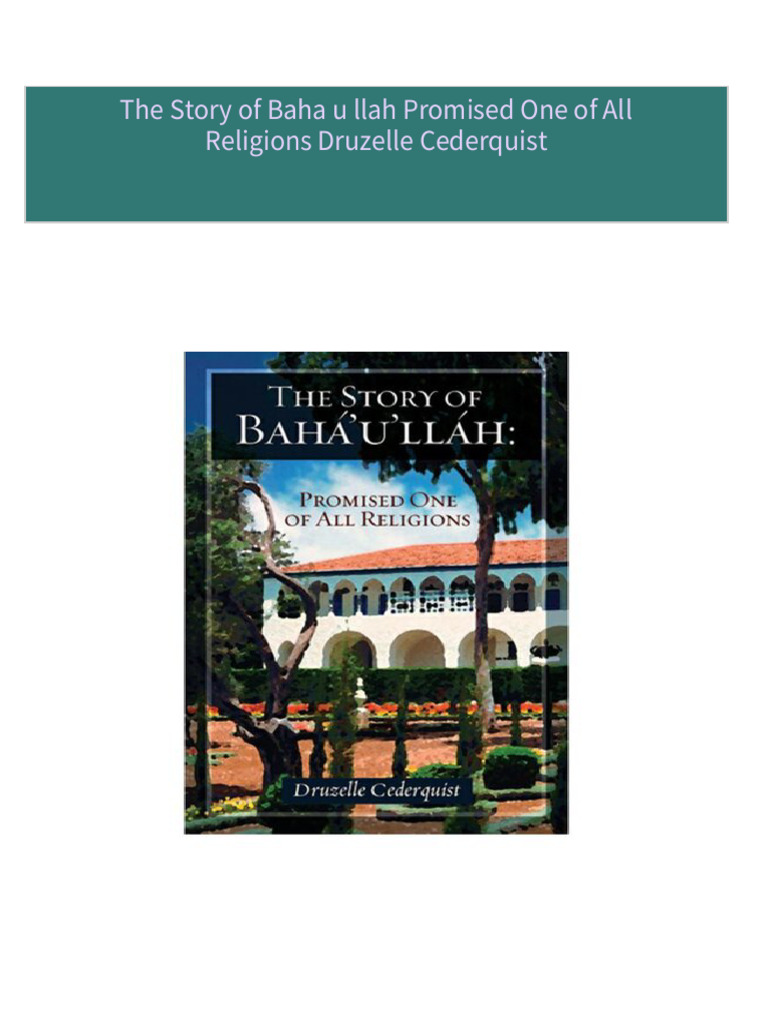The Bahá’í Faith, a religion founded in the mid-19th century by Bahá’u’lláh, is steeped in prophetic teachings that reflect a profound understanding of divine purpose and the evolution of spirituality through the ages. Central to this belief system is the concept of the “Promised One”—a figure anticipated by various religious traditions. This article delves into the Bahá’í interpretation of prophecy and examines how it uniquely positions Bahá’u’lláh within the continuum of divine messengers.
To comprehend the Bahá’í perspective on prophecy, it is essential to explore the broader context of religious history. Prophecy is often viewed not merely as a foretelling of future events but rather as an awakening—to the possibilities of divine intervention and the unfolding of a greater plan. This viewpoint posits that each religious dispensation prepares humanity for the subsequent revelations of God. It is akin to a symphony, where each instrument adds a layer of harmony, culminating in a divine crescendo that is both transformative and profound.
Bahá’í teachings elucidate this concept through the metaphor of the “Promised One.” In various religious traditions, from Judaism’s awaited Messiah to Christianity’s Second Coming and Islam’s Mahdi, there exists a common thread: the anticipation of a divine figure destined to usher in an era of peace and enlightenment. Bahá’ís assert that Bahá’u’lláh embodies this promise, fulfilling the long-awaited quest for spiritual renewal across the world.
A pivotal aspect of understanding Bahá’u’lláh’s prophetic mission lies in the reinterpretation of scriptural texts. Bahá’ís advocate for a progressive revelation, suggesting that prior scriptures contain premonitions of Bahá’u’lláh’s advent. The Qur’an, for instance, alludes to the return of the Mahdi, translating into contemporary expectations of spiritual leaders who come with unique messages for each age. In this light, Bahá’u’lláh is positioned not only as the culmination of previous prophecies but also as a transformative figure who breathes new life into humanity’s spiritual journey.
This spiritual evolution is depicted through an intricate tapestry of symbolism. The imagery of the “tree of life,” a recurrent motif in numerous religious texts, serves as a profound metaphor for growth, fertility, and perpetual renewal. In the Bahá’í context, the tree’s roots represent foundational truths that seed future understanding, while its branches symbolize the diverse manifestations of God’s message in different eras. Bahá’u’lláh, then, is perceived as the vibrant foliage, bringing forth a new understanding that nourishes the souls of those willing to partake in its fruits.
However, the Bahá’í interpretation of the Promised One transcends mere fulfillment of prophecies. It involves a larger, more immediately relevant discourse on unity and the collective advancement of humanity. As Bahá’u’lláh proclaimed, the world is in dire need of reconciliation and collaboration among its diverse peoples. His teachings encapsulate not just the future hope of a Promised One but also a blueprint for universal peace—urging followers to recognize the interconnectedness of all creation.
This vision compels Bahá’ís to engage actively in community-building efforts, bridging divides that have long plagued societies. The invocation of the Promised One is not simply an abstract concept; rather, it becomes a rallying cry for action. Through this lens, the prophetic role is reimagined—not as the bearer of divine judgments but as a guiding light that invites humanity into a participatory relationship with the divine will.
Moreover, the teachings of Bahá’u’lláh are imbued with a rich ethical framework that advocates for social justice, equality, and the eradication of prejudice. These principles form the bedrock of a new societal paradigm where the teachings of the Promised One are expected to usher in unprecedented harmony. This expectation is not passive but requires an active commitment to the ideals and virtues espoused by Bahá’u’lláh.
As the Bahá’í community advances, it finds itself within a global landscape marked by both challenges and opportunities. The Promised One’s teachings resonate particularly fiercely in a time where the notions of justice and equality seem increasingly urgent. The system of world governance is often critiqued for failing to uphold human dignity, yet Bahá’í thought provides constructive solutions envisioned by the Promised One—a synthesis of justice, moral integrity, and compassion.
This commitment to a higher ethic ties back to the overarching narrative of prophetic fulfillment. The Bahá’í teachings present an intricate dialogue between past expectations and present realities. The fervent hope for the return of the Promised One persists as an anchor, guiding individuals and communities alike as they navigate the tumultuous currents of contemporary existence.
In conclusion, the Bahá’í view of the Promised One integrates a historical legacy of prophetic insight with an urgent call for soulful engagement in today’s world. It is an invitation, not only to acknowledge Bahá’u’lláh as the long-anticipated figure of prophecy but also to embody the principles He espoused. In recognizing this dual responsibility, humanity stands at the precipice of a transformative era—one where the teachings of the Promised One illuminate the path towards a unified and harmonious global society.
